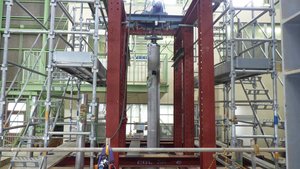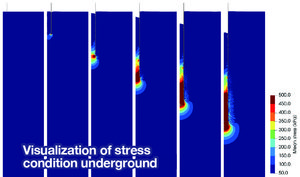Major Research 3A Research on Development and Utilization of Oceans
Background and Objectives
Since the 1960s, the importance of marine utilization and development has been pointed out. Various approaches for this purpose have been taken, but the progress remains inadequate. One of the reasons is the lack of infrastructure at sea as a hub. Therefore, marine hub ports should be constructed on remote islands including Minamitorishima Island and Okinotorishima Island to promote marine utilization and development. These remote islands are surrounded by severe sea wave environment and severe sea climate for port construction which are different from those of general ports in main islands. Further technological development is required to ensure smooth ship berthing, cargo-handling, and port construction. Therefore, in this research theme, we will make maximum use of previously accumulated knowledge regarding waves, sea-bed ground, port structures, and port construction to construct ports on remote islands, and will also promote marine utilization and development. Specifically, we will clarify the characteristics of waves in isolated reef areas, and will develop a new mooring system for ships. We will also develop technologies for downsizing and reducing the weight of underwater acoustic video cameras, as well as utilization and development.
Research Topics
Research and development are being conducted on the following subjects for the development and utilization of oceans.
For our development of a fender system for automatic ship berthing/unberthing, we are conducting elemental experiments using a scale model focusing on the adsorption mechanism of the fender system to examine its structural stability including the adsorption effect.
For our research on underwater construction machines that utilize machine guidance technology to integrate multiple functions, we are creating the basic design of a task information presentation system with which the machines can be adapted to other types of work, while modifying the foundation-leveler attachment for better adaptation to actual on-site operations and conducting tests to check the accuracy of the acoustic positioning system.
For our research on an acoustic imaging system, we are examining the feasibility of implementing the acoustic system in the project for harnessing ICT in dredging, based on the results of actual sea area dredging experiments that had been conducted by the previous year involving seafloor excavation and soil replacement tasks.
For our research on the wave force and scouring that affect offshore wind power generation facilities, we are comparing and examining the wave force calculation results that were obtained in the previous year from the wave force experiment data and numerical simulation (CADMAS-SURF) and are also conducting a large-scale experiment on scour protection around a circular cylinder.
For our research on the horizontal resistance characteristics of pile foundations at offshore wind power generation facilities, we are conducting horizontal loading experiments repetitively under such conditions that are more similar to actual related phenomena, including a centrifugal model experiment that involves the use of a wave generation machine and a multi-directional loading experiment.
For our research on the mechanical properties and durability of infrastructure materials in the deep sea, we are experimentally studying the physical properties of concrete under high water pressure loading. We have also recovered the test specimens exposed to the deep sea floor in the Nankai Trough (underwater depth of approx. 3,515 m). We are analyzing the data of the internal water pressure and the strain data monitored during exposure along with their deterioration condition, etc.
Activities in FY 2021
Concerning advancement of harbor tranquility in a remote island, we selected a quay by complex wave field that is created due to multiple wave reflections and performed wave deformation calculations using NOWT-PARI to obtain wave data penetrating the quay. While a remote island quay is also exposed to a similar wave field in an ocean, we applied both the conventional and our novel methods to calculate the amounts of ship oscillation moored there. The former is conducted by assuming that all the waves are one-directional and assigning them to the frequency spectrum, and the latter is conducted by entering the surface wave profiles into CADMAS-SURF/3D which is improved for calculating with floating objects. We then compared the calculation results obtained using the two different methods and examined the differences.
As for the development of a fender system for automatic ship birthing/unberthing, we conducted elemental experiments using a scale model to test the adsorption mechanism of the fender system and were able to verify its structural stability including the adsorption effect. Also, we reviewed the results of the numerical calculation using a moored ship oscillation simulation to examine the effectiveness of the fender system in terms of its mooring capability, etc. for ships while they are moored for cargo handling.
For our study on methods for enhancing marine ecological values on gray infrastructure toward establishing green-gray hybrid infrastructure, we installed several different types of test specimens along a seawall on the coast of Kitakyushu. Then, we monitored the development of algae. Also, we tested several substrate materials (steel, stainless steel, and acryl) to develop a technique for coral reskinning to clarify the substrate preferred for coral covering. Also, we performed instrumental analysis to elucidate the mechanism of coral covering. Furthermore, we analyzed several existing cases of green-gray hybrid infrastructure installations in Japan and other parts of the world. This was done to organize the ideas on the optimal hybrid infrastructure concept in terms of global land space scale and local structure(s)-scale.
For the integration of multiple functions in our underwater construction machines utilizing machine guidance technology, we conducted a review of the functions for adapting our task information presentation system to other types of work. In addition, we took the machines to Naha Port and Ishigaki Port to examine how well adapted the mounted underwater machine guidance technology and the remote operation support system were to actual operation sites and identified potential operational issues that needed to be addressed.
For the application of our acoustic imaging system to ICT-based construction projects, we conducted an underwater visualization experiment using acoustic video cameras for real-time monitoring of construction tasks as they were being executed, with the eventual goal of achieving autonomous operation of dredging ships. In addition, we established a multibeam data cloud processing system (AIMS) and conducted a surveying test with it (4G and local Wi-Fi) that involved marine telecommunication. Concerning our ICT-based underwater surveying project, we measured data from the top surfaces of rubble mounds at structures' foundations and verified the measurement precision of our technique by comparing the data to the crosssections of the structures' designs, and also developed a visualization tool, etc. that could be applied to both underwater and on-ship tasks.
For our study of the wave force and scouring that affect offshore wind turbine foundations, we conducted a large scale hydraulic experiment on the effectiveness of a stone filled net as a scour protection around the circular cylinder of offshore wind turbines at the Large Hydro-Geo Flume (LHGF).
Concerning the research on the horizontal resistance characteristics of the pile foundation at an offshore wind power generation facility, which is subject to various fluctuating loads, we built model piles that have larger diameters than the ones made in the previous year and tested them in a pile penetration and horizontal loading experiment in a large soil tank to examine the effects of pile diameter on the horizontal resistance characteristics of the piles. In addition, we used a numerical analysis method that could simulate the process of piles penetrating the ground to study how the process would affect the horizontal resistance characteristics of the piles.

Horizontal loading experiment involving a
large-diameter pile

Numerical analysis of the pile penetration process
Concerning the research on load setting method for offshore wind turbines in wind and waves, using meteorological, oceanographic, and structural data corrected in the previous year, we investigated the dynamic response characteristics of 5MW, 10MW, and 15MW offshore wind turbines to wind and waves through a coupled load analysis called OpenFAST.
Concerning the research on the mechanical properties and durability of infrastructure materials in the deep sea, we performed loading experiment under high water pressure on the infrastructure materials. Also, we developed the tanks in which low temperature seawater flows. Thanks to these tanks, we clarified the durability of concrete in a low-temperature seawater. As a result, the rate of deterioration is different for different types of cement-based materials. Furthermore, we recovered a circular column specimen from the deep sea floor at 3515 m in the Nankai Trough exposed for 1 year. The specimen was subjected to instrumental analysis. We also started a new exposure experiment involving reinforced concrete beam specimens.



